VOLVO 850 User Manual
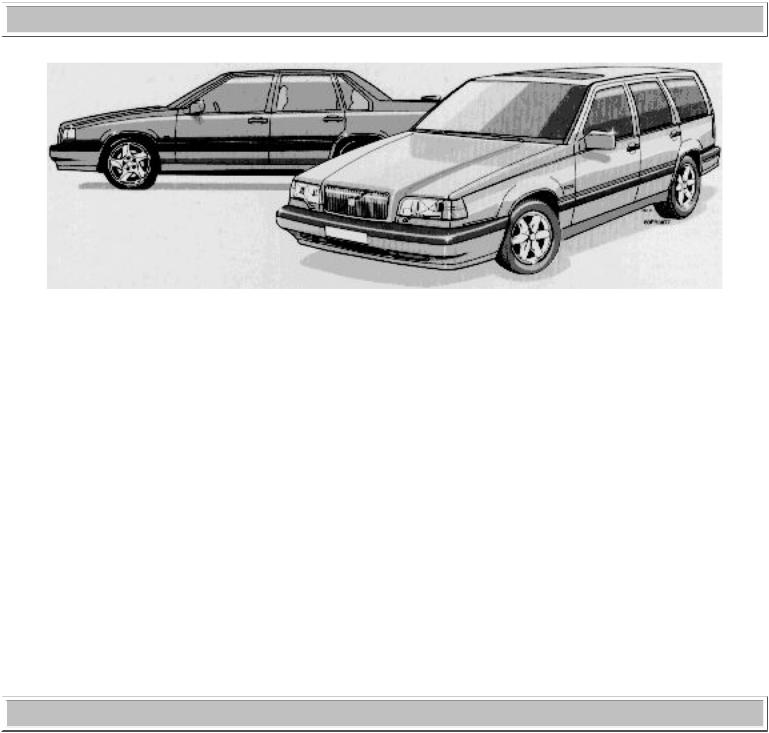
1997 Volvo 850
850 Model
VOLVO 850
1 9 9 7 VOLVO
 This manual deals with the operation and care of your Volvo.
This manual deals with the operation and care of your Volvo.
Welcome to the world-wide family of Volvo owners. We trust that you will enjoy many years of safe driving in your Volvo, an automobile designed with your safety and comfort in mind. To help ensure your satisfaction with this vehicle, we encourage you to familiarize yourself with the equipment descriptions, operating instructions and maintenance requirements/recommendations in this manual. We also urge you and your passengers to wear seat belts at all times in this (or any other) automobile. And, of course, please do not operate a vehicle if you may be affected by alcohol, medication or any impairment that could hinder your ability to drive.
Your Volvo is designed to meet all applicable safety and emission standards, as evidenced by the certification labels attached to the driver's door opening and on the left wheel housing in the engine compartment.
 Volvo and the environment
Volvo and the environment
Volvo is committed to the well being of our customers. As a natural part of this commitment, we care about the environment in which we all live. Caring for the environment means an everyday involvement in reducing our environmental impact.
http://new.volvocars.com/ownersdocs/1997/1997_850/97850_000.htm (1 sur 4) [2013-03-14 11:17:29]
1997 Volvo 850
Volvo's environmental activities are based on a holistic view, which means we consider the overall environmental impact of a product throughout its complete life cycle. In this context, design, production, product use, and recycling are all important considerations.
In production, Volvo has partly or completely phased out several chemicals including freons, lead chromates, naphtanates, asbestos, mercury and cadmium; and reduced the amount of chemicals used in our plants 50% since 1991.
In use, Volvo was the first in the world to introduce into production a three-way catalytic converter with a Lambda sond, now called oxygen sensor, in 1976. The current version of this highly efficient system reduces emissions of harmful substances (CO, HC, NOx) from the exhaust pipe by approximately 95% and the search to eliminate the remaining emissions continues. Volvo is the only automobile manufacturer to offer CFC-free retrofit kits for the air conditioning system for all models back to the M/Y 1975 240. Advanced electronic engine controls, refined purification systems and cleaner fuels are bringing us closer to our goal.
In addition to continuous environmental refinement of conventional gasoline-powered internal combustion engines, Volvo is actively looking at advanced technology alternative-fuel vehicles and the Dynaguide Information System (an advanced traffic information system).
When you drive a Volvo, you become our partner in the work to lessen the car's impact on the environment.
To reduce your vehicle's environmental impact, you can:
●Maintain proper air pressure in your tires. Tests have shown decreased fuel economy with improperly inflated tires
●Follow the recommended maintenance schedule
●Drive at a constant speed
●See an authorized Volvo retailer as soon as possible for inspection if the check engine (malfunction indicator) lamp illuminates, or stays on after the vehicle has started
●Properly dispose of any vehicle related waste such as used motor oil, used batteries, brake pads, etc.
http://new.volvocars.com/ownersdocs/1997/1997_850/97850_000.htm (2 sur 4) [2013-03-14 11:17:29]

1997 Volvo 850
For additional information regarding the environmental activities in which Volvo Cars of North America, Inc. is involved, visit our Internet Environmental Home Page at: http://www.volvocars.com/environment.html
 Contents
Contents
Important
Before you operate your car for the first time, please familiarize yourself with the BREAK-IN information on page 4:2. You should also be familiar with the information in the first three chapters of this manual.
Information contained in the balance of the manual is extremely useful and should be studied after operating the vehicle for the first time.
This manual is structured so that it can be used for reference. It should thus be kept in the car for ready access.
Do not export your Volvo to another country before investigating the country's applicable safety and exhaust emission requirements. In some cases it may be difficult or impossible to comply with these requirements. Modifications to the emission control system(s) may render your Volvo not certifiable for legal operation in the U.S., Canada or other countries.
1Occupant safety, Reporting safety defects
2Instruments and controls
3Body and interior
4Starting and driving
5Wheels and tires
6In case of emergency
7Car care
8Service and routine maintenance
9Specifications
10Audio systems
All information, illustrations and specifications contained in this manual are based on the latest product information available at the time of publication. Volvo reserves the right to make model changes at any time, or to change specifications or design, without notice and without incurring obligation.
http://new.volvocars.com/ownersdocs/1997/1997_850/97850_000.htm (3 sur 4) [2013-03-14 11:17:29]

1997 Volvo 850
CAUTION: The 850 R turbo models have reduced ground clearance due to the design of the front spoiler. Please observe caution when e.g., driving onto garage hoists, through drifted snow or when other road debris is encountered, or when parking near curbs.
1996 Volvo Cars of North America Inc.
Contents | Top of Page
http://new.volvocars.com/ownersdocs/1997/1997_850/97850_000.htm (4 sur 4) [2013-03-14 11:17:29]
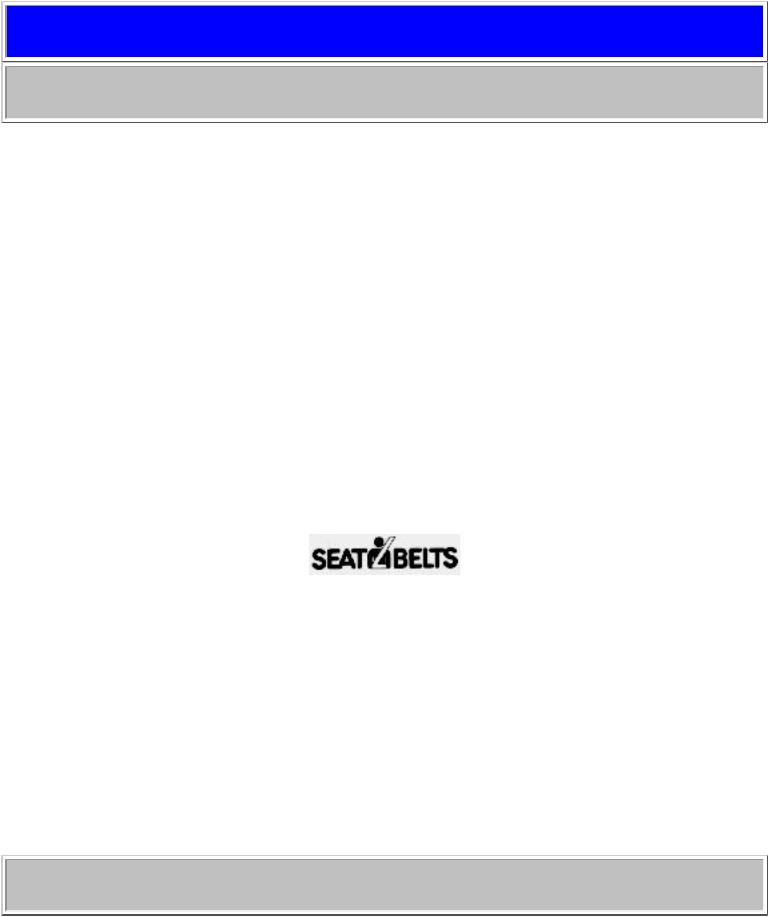
1997 Volvo 850
Occupant safety, Reporting safety defects
pg. 1:1 Occupant safety
Occupant safety
Despite our strongest recommendations, and your best intentions, not wearing a seat belt is like believing "It'll never happen to me!". Volvo urges you and all adult occupants of your car to wear seat belts and ensure that children are properly restrained, using an infant, car or booster seat determined by age, weight and height.
Fact: In every state and province, some type of child-restraint legislation has been passed. Additionally, most states and provinces have already made it mandatory for occupants of a car to use seat belts.
So, urging you to "buckle up" is not just our recommendation - legislation in your state or province may mandate seat belt usage. The few seconds it takes to buckle up may one day allow you to say, "It's a good thing I was wearing my seat belt".
1:2 Seat belts
1:4 Volvo SRS
1:8 Side Impact Protection System - (SIPS) air bag
1:9 Child safety
1:13 Occupant safety
1:13 Reporting Safety Defects
pg. 1:2 Seat belts
Seat belts
http://new.volvocars.com/ownersdocs/1997/1997_850/97850_101.htm (1 sur 4) [2013-03-14 11:17:38]
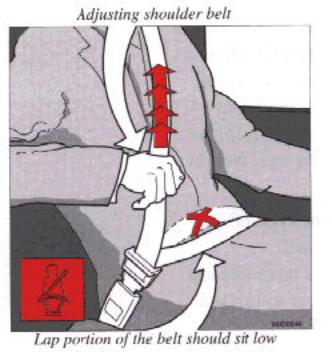
1997 Volvo 850
Always fasten the seat belts before you drive or ride.
Two lights above the rear view mirror will be illuminated for 4-8 seconds after the starting (ignition) key is turned to the driving position. A chime will sound at the same time if the driver has not fastened his seat belt. The rear seats are provided with self-retracting inertia reel belts. The front seats are provided with single roller belts with tensioners.
To buckle:
Pull the belt out far enough to insert the latch plate into the receptacle (buckle for rear seats) until a distinct snapping sound is heard. The seat belt retractor is normally "unlocked" and you can move freely, provided that the shoulder belt is not pulled out too far. The retractor will lock up as follows:
●if the belt is pulled out rapidly
●during braking and acceleration
●if the vehicle is leaning excessively
●when driving in turns
For the seat belt to provide maximum protection in the event of an accident, it must be worn correctly. When wearing the seat belt remember:
●The belt should not be twisted or turned.
●The lap belt must be positioned low on the hips (not pressing against the abdomen).
●The shoulder section of the front seat belts adjusts automatically to the driver's height.
Make sure that the shoulder belt is rolled up into its retractor and that the shoulder and lap belts are taut.
Before exiting the car, check that the seat belt retracts fully after being unbuckled. If necessary, guide the belt back into the retractor slot.
http://new.volvocars.com/ownersdocs/1997/1997_850/97850_101.htm (2 sur 4) [2013-03-14 11:17:38]
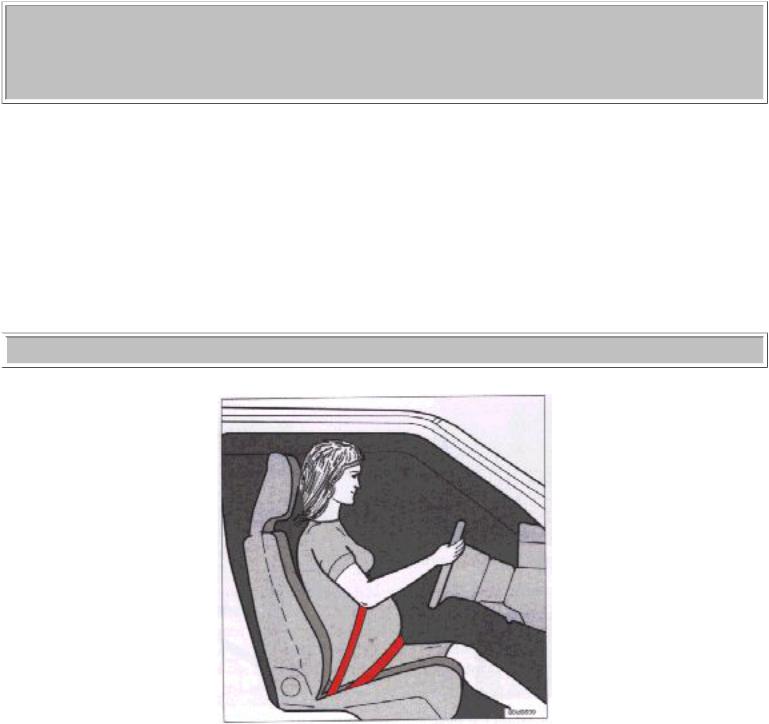
1997 Volvo 850
NOTE: Legislation in your state or province may mandate seat belt usage.
WARNING! Any device used to induce slack into the shoulder belt portion of the three-point belt system will have a detrimental effect on the amount of protection available to you in the event of a collision. The seat back should not be tilted too far back. The shoulder belt must be taut in order to function properly.
Spool-out
To make child seat installation easier, each seat belt buckle (except for the driver's belt) is equipped with a locking mechanism to help keep the lap section of the seat belt taut. Please refer to page 1:11 for more information on this function.
 pg. 1:3 Seat belts, Center head restraint
pg. 1:3 Seat belts, Center head restraint
During pregnancy
Pregnant women should always wear seat belts. Remember that the belt should always be positioned in such a way as to avoid any possible pressure on the abdomen. The lap portion of the belt should be
http://new.volvocars.com/ownersdocs/1997/1997_850/97850_101.htm (3 sur 4) [2013-03-14 11:17:38]
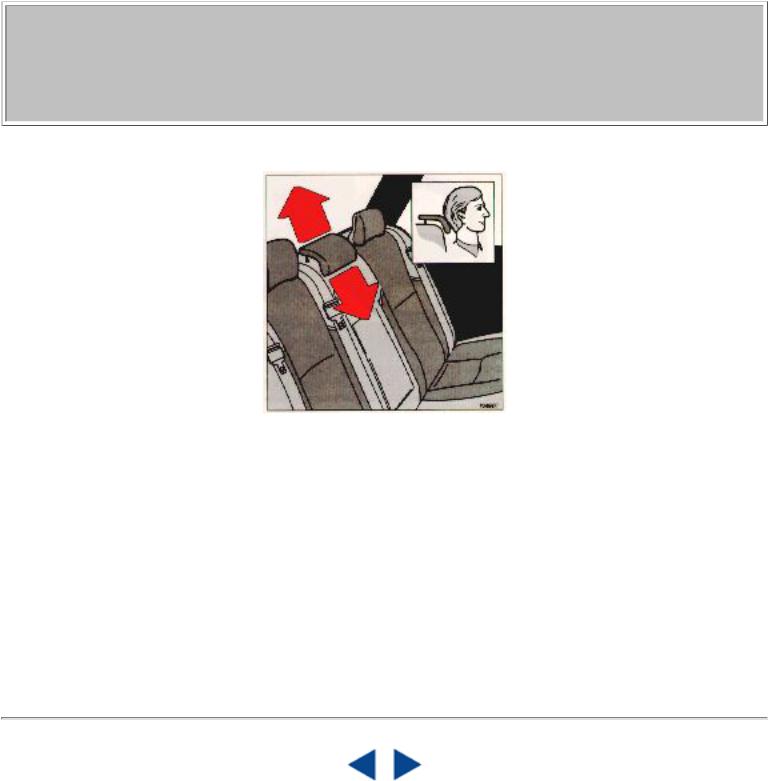
1997 Volvo 850
located low, as shown in the above illustration.
WARNING! Never use a seat belt for more than one occupant. Never wear the shoulder portion of the belt under the arm, behind the back or otherwise out of position. Such use could cause injury in event of accident. As the seat belts lose much of their strength when exposed to violent stretching, they should be replaced after any collision, even if they may appear to be undamaged. Never repair the belt on your own; have this done by an authorized Volvo retailer only.
Center head restraint
The center head restraint can be adjusted according to the passenger's height. The restraint should be carefully adjusted to support the occupant's head.
To raise: Pull straight up
To lower: Pull forward and push down
Contents | Top of Page
http://new.volvocars.com/ownersdocs/1997/1997_850/97850_101.htm (4 sur 4) [2013-03-14 11:17:38]
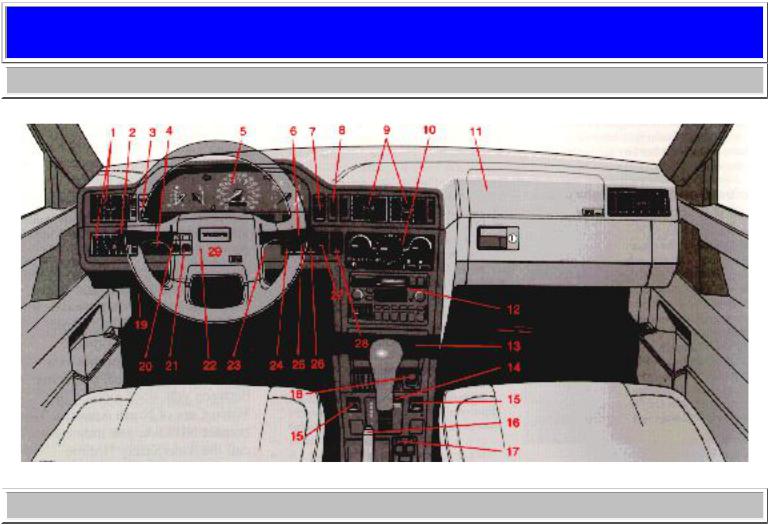
1997 Volvo 850
Instruments and controls
 Instruments, switches and controls
Instruments, switches and controls
 pg. 2:1 Instruments, switches and controls (cont.)
pg. 2:1 Instruments, switches and controls (cont.)
IMPORTANT! (Automatic transmission only)
Your car is equipped with a Shiftlock-Keylock system.
SHIFTLOCK:
When your car is parked, the gear selector is locked in the (P)ark position. To release the selector from this position, turn the ignition key to position II (or start the engine), depress the brake pedal, press the button on the front side of the gear selector and move the selector from (P)ark.
If it is necessary to manually override the shiftlock system:
●Turn the starting (ignition) key to position I
●Press firmly on the "SHIFTLOCK OVERRIDE" button located near the base of the gear selector.
●While holding the override button down, press the button on the front of the gear selector.
●Move the gear selector from the ( P )ark position.
http://new.volvocars.com/ownersdocs/1997/1997_850/97850_201.htm (1 sur 10) [2013-03-14 11:17:48]
1997 Volvo 850
KEYLOCK
This means that when you switch off the ignition, the gear selector must be in the (P)ark position before the starting (ignition) key can be removed from the ignition switch.
ANTI-LOCK BRAKE SYSTEM (ABS)
The ABS system in your car performs a self-diagnostic test when the vehicle first reaches the speed of approximately 12 mph (20 km/h). The brake pedal will pulsate several times and a sound may be audible from the ABS control module. This is normal.
The pages in this section provide detailed descriptions of the vehicle's instruments and controls. Note that vehicles may be equipped differently, depending on special legal requirements.
pg. 2:19 |
1 |
Air vents |
pg. 2:6 |
2 |
Turn signals, high/low beams |
pg. 2:15 |
cruise control |
|
pg. 2:8 |
3 |
Rear fog light, instrument illumination |
pg. 2:6 |
4 |
Headlights, parking lights |
pg. 2:2-2:5 |
5 |
Instruments |
pg. 2:7 |
6 |
Windshield wiper/washer |
pg. 2:9 |
7 |
Hazard warning flashers |
pg. 2:19 |
8 |
Air mix |
pg. 2:19 |
9 |
Air vents |
pg. 2:19-2:23 |
10 |
Heating and ventilation controls |
pg. 1:4, pg. 1:6 |
11 |
Passenger side SRS (air bag) hatch |
pg. 10:1 |
12 |
Audio system |
pg. 2:17 |
13 |
Ash tray |
pg. 6:18 |
14 |
Shiftlock release button (automatic transmission only) |
http://new.volvocars.com/ownersdocs/1997/1997_850/97850_201.htm (2 sur 10) [2013-03-14 11:17:48]

1997 Volvo 850 |
|
|
pg. 2:16 |
15 |
Electrically heated front seats (optional) |
pg. 2:17 |
16 |
Parking brake |
pg. 2:24 |
17 |
Electrically operated windows |
pg. 3:7 |
Side door mirrors |
|
pg. 2:17 |
18 |
Cigarette lighter |
pg. 3:10 |
19 |
Hood release |
pg. 2:8 |
20 |
Front fog lights (optional) |
pg. 2:8 |
21 |
Central locking button |
pg. 2:18 |
22 |
Adjustable steering wheel |
pg. 2:7 |
23 |
Starting (ignition) switch/steering wheel lock |
– |
24 |
Space for additional equipment |
2:3,pg. 2:5,pg. 2:9 25 |
Traction control system (optional) |
|
pg. 2:9 |
26 |
Electrically operated sun roof (optional) |
pg. 2:12-14 |
27 |
Trip computer (optional) |
pg. 2:9 |
28 |
Heated rear window/heated door mirrors |
pg. 1:4 |
29 Horn/SRS |
|
Some of the items above are available on certain models only.
pg. 2:2 Instruments
1 Fuel gauge
http://new.volvocars.com/ownersdocs/1997/1997_850/97850_201.htm (3 sur 10) [2013-03-14 11:17:48]
1997 Volvo 850
The fuel tank holds approximately 19.3 US gals. (73 liters). When the warning light comes on there is approximately 1.8 US gals. (8 liters) of fuel remaining. See "Refueling" for further information.
2 Boost pressure gauge
(Certain turbo-charged models only)
The boost pressure gauge is divided into sections. Black section: The engine acts as a normally aspirated engine. Best fuel economy is achieved while driving in this range. White section: The turbocharger provides boost pressure.
3 Temperature gauge
Do not drive the car with the pointer in the red range . The pointer should be approximately midway on the gauge face when driving. If the pointer approaches the red range repeatedly, check coolant level. See page 4:10.
4 Trip odometer reset button
5 Clock, ambient temperature sensor (certain models), trip computer (certain models)
Indicates the temperature slightly above the surface of the road. An amber warning lamp lights up when the temperature is in the range of 23-36° F (-5 - + 2° C). At low speeds or when the car is not moving, the temperature readings may be slightly higher than the actual ambient temperature due to heat generated by the engine.
6 Speedometer
http://new.volvocars.com/ownersdocs/1997/1997_850/97850_201.htm (4 sur 10) [2013-03-14 11:17:48]
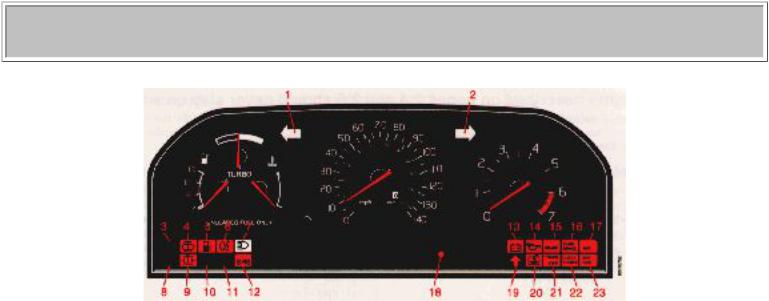
1997 Volvo 850
7Odometer
8Trip odometer
Used for measuring shorter distances. The last digit indicates 1/10 mile/kilometer. A black number on a white background = original speedometer. A red number on a white background = replacement speedometer.
9 Tachometer
Reads thousands of engine rpm. The engine should not be operated in red range.
The highest permitted constant engine speed is 6,300 rpm (turbo-charged models: 6,200 rpm, B 5252 S: 6,000 rpm).
pg. 2:3 Indicator and warning lights
1 Turn signal, left
2 Turn signal , right
3 (Not in use)
4 Low washer fluid level
If the lamp glows continuously when the engine is running, there is only about 1/2 - 1 US qt.
http://new.volvocars.com/ownersdocs/1997/1997_850/97850_201.htm (5 sur 10) [2013-03-14 11:17:48]

1997 Volvo 850
remaining in the washer fluid reservoir. 5 Low fuel level
When the lamp glows, only about 1.8 US gals. (8 liters) of fuel remain. If the ignition is switched on while refueling, the gauge may read inaccurately for up to 45 minutes.
6 Rear fog light
7 High beams
8 (Not in use)
9 Bulb failure warning sensor
10 (Not in use)
11 (Not in use)
12SRS
13Generator not charging
14Low engine oil pressure
15Brake warning light
16Parking brake applied
17ABS-system
18Ambient temperature warning light* (certain models) (See pp. 2:11 or 2:14 for more information)
19Transmission mode "W", or gear positions 3 or L engaged (automatic transmissions)
20Low coolant level
21Traction Control System (option)
22Malfunction indicator lamp
(See page 2:4 for more information) 23 Service reminder indicator
* Warning light is amber.
pg. 2:4 Warning lights
The warning lights described on pages 2:4 and 2:5 should never stay on when driving
When the ignition key is turned on, and before the engine starts, all of the warning lights should be on to test the function of the bulbs. Should a light not go off after the engine has started, the system indicated should be inspected. However, the parking brake reminder light will not go off until the parking brake is fully released.
 Generator warning light
Generator warning light
http://new.volvocars.com/ownersdocs/1997/1997_850/97850_201.htm (6 sur 10) [2013-03-14 11:17:48]
1997 Volvo 850
If the light comes on while the engine is running, have the charging system checked.
 Malfunction indicator lamp
Malfunction indicator lamp
If the lamp comes on (or stays on after the vehicle has started), the engine diagnostic system has detected a possible fault in the emission control system. Although driveability may not be affected, see an authorized Volvo retailer as soon as possible for inspection.
NOTE: If the fuel filler cap is not closed tightly or if the engine is running when the car is refueled, the Malfunction Indicator Lamp may indicate a fault. Use only Volvo original or approved fuel filler caps.
 Oil pressure warning light
Oil pressure warning light
If the light comes on while driving, stop the car and then stop the engine immediately and check the engine oil level. See page 8:10. If the light stays on after restart, have the car towed to the nearest authorized Volvo retailer. After hard driving, the light may come on occasionally when the engine is idling. This is normal, provided it goes off when the engine speed is increased.
 Parking brake reminder light
Parking brake reminder light
This light will be on when the parking brake (hand brake) is applied. The parking brake lever is situated between the front seats. Canadian models are equipped with this warning light: 
http://new.volvocars.com/ownersdocs/1997/1997_850/97850_201.htm (7 sur 10) [2013-03-14 11:17:48]

1997 Volvo 850
 Brake fluid warning light
Brake fluid warning light
If the light comes on while driving or braking, stop immediately, open the hood and check the brake fluid level in the reservoir. See pages 8:17-18 for reservoir position.
Canadian models are equipped with this warning light: 
WARNING!
If the fluid level is below the MIN mark in either section of the reservoir: DO NOT DRIVE. Tow the car to a Volvo retailer and have the brake system checked and any leakage repaired.
pg. 2:5 Warning lights (cont.)
 TRACS disengaged (option)
TRACS disengaged (option)
If the TRACS (TRAction Control System) is manually disengaged with the switch on the dashboard, the warning light will come on. This will also come on to indicate a TRACS malfunction, and when the brakes overheat, although it goes out again at the normal temperature level. If the lamp remains on, the system should be checked by an authorized Volvo retailer. This lamp should not be confused with the ON/OFF indicator lamp above the switch. See page 2:9 for additional information.
 Anti-lock Brake System (ABS)
Anti-lock Brake System (ABS)
If the warning lamp lights up there is a malfunction of the ABS system (the standard braking system will however function). The vehicle should be driven to a Volvo retailer for inspection.
See page 4:16 for additional information.
Canadian models are equipped with this warning light: 
http://new.volvocars.com/ownersdocs/1997/1997_850/97850_201.htm (8 sur 10) [2013-03-14 11:17:48]
1997 Volvo 850
 Coolant level sensor
Coolant level sensor
If the light comes on while driving, the coolant level is low. The coolant level in the expansion tank should be checked immediately and topped up if necessary. The cooling system should be inspected by an authorized Volvo retailer.
 Mode "W" engaged
Mode "W" engaged
The lamp will light up when the Winter/Wet starting mode is engaged or if gears "3" or "L" are selected.
If the warning lamp begins to flash , this means that there is a fault in the automatic gearbox. Contact your Volvo retailer.
 Supplemental Restraint System (SRS)
Supplemental Restraint System (SRS)
If the light comes on (or stays on after the vehicle has started), the SRS diagnostic system has detected a fault. Drive to an authorized Volvo retailer for an inspection of the system. See the SRS section for more information.
 Service reminder indicator
Service reminder indicator
This light will come on at 10,000 mile (16,000 km) intervals*, after 750 hours of driving or after 12 months, whichever occurs first. It is a reminder to the driver that the service interval has been exceeded. The light will stay on for 2 minutes after the start until reset by the servicing retailer.
* Turbo-charged model intervals: 5,000 miles (8,000 km), 500 hours of driving or after 12 months, whichever occurs first.
http://new.volvocars.com/ownersdocs/1997/1997_850/97850_201.htm (9 sur 10) [2013-03-14 11:17:48]

1997 Volvo 850
 Bulb failure warning light
Bulb failure warning light
The light will come on if any of the following bulbs are defective:
●one of the low beam headlights
●one of the tail lights
●one of the brake lights when the brake pedal is depressed.
Check the fuse and bulb. See sections "Replacing bulbs" and "fuses".
Should the warning light come on after a defective outside bulb has been replaced, the corresponding bulb on the other side of the car should also be replaced.
Contents | Top of Page
http://new.volvocars.com/ownersdocs/1997/1997_850/97850_201.htm (10 sur 10) [2013-03-14 11:17:48]

1997 Volvo 850
Body and interior
pg. 3:1 Body and interior
Body and interior
The seats, sun roof, mirrors, etc. are described on the following pages.
pg. 3:2 |
Keys |
pg. 3:3 |
Doors and locks |
pg. 3:4 |
Remote keyless entry system |
pg. 3:5 |
Alarm |
pg. 3:6-7 |
Front seats |
pg. 3:7 |
Rear/side view mirrors |
pg. 3:8 |
Interior lights, Vanity mirror |
pg. 3:9 |
Sun roof |
pg. 3:10 |
Hood |
pg. 3:11 |
Storage compartments |
pg. 3:12 |
Child safety locks, Trunk lid |
pg. 3:13 |
Tailgate, Child safety lock |
pg. 3:14 |
Trunk light, Spare tire, Jack |
pg. 3:15 |
Cargo space lighting, Spare tire, Jack (wagon) |
pg. 3:16 |
Folding rear seat (sedan) |
pg. 3:17 |
Folding rear seat (wagon) |
pg. 3:18 |
Removing seat cushions |
pg. 3:19 |
Concealed storage bins (wagon) |
pg. 3:20 |
Luggage net (wagon) |
pg. 3:21 |
Securing cargo |
pg. 3:22 |
Folding front seat, Long load storage |
http://new.volvocars.com/ownersdocs/1997/1997_850/97850_301.htm (1 sur 8) [2013-03-14 11:17:58]
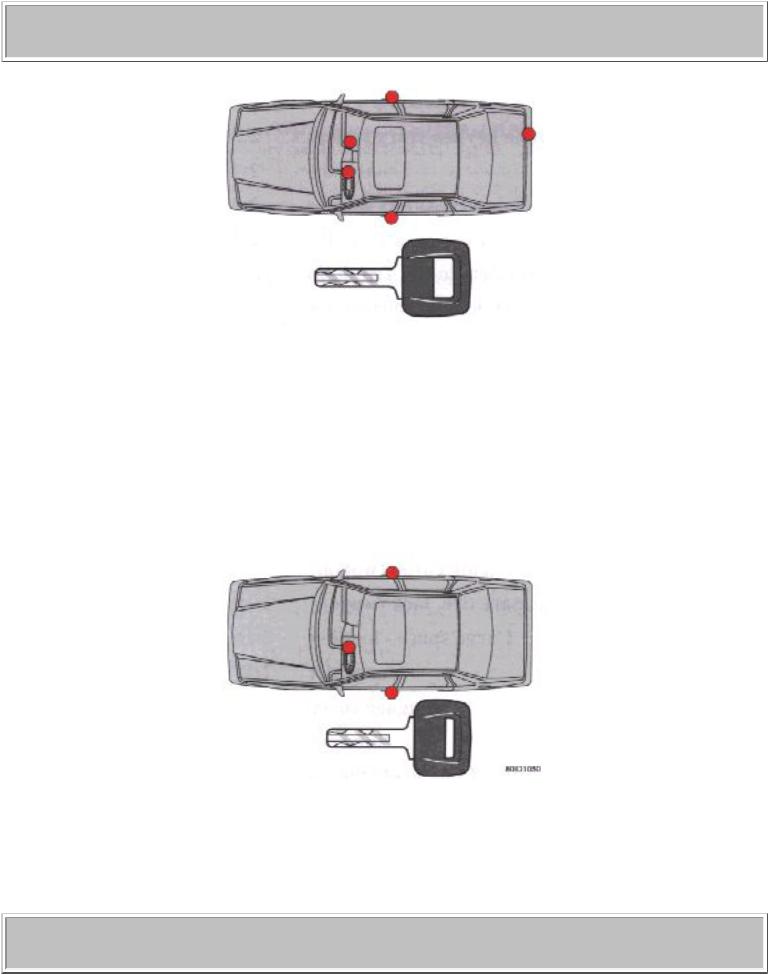
1997 Volvo 850
pg. 3:2 Keys
Master key
This key operates all locks
The key number codes are stamped on a separate tag supplied with the keys. This tag should be separated from the key ring and kept in a safe place.
An an added anti-theft measure, new keys have been developed which may take slightly longer to copy or replace if the original keys are misplaced.
Service key
Front doors, starting (ignition) switch/steering wheel lock
In the event the original keys are lost, duplicates may be ordered from your Volvo retailer. The central locking system is described in detail in the section "Doors and locks".
pg. 3:3 Doors and Locks
http://new.volvocars.com/ownersdocs/1997/1997_850/97850_301.htm (2 sur 8) [2013-03-14 11:17:58]

1997 Volvo 850
Doors and locks
Your car is equipped with a two door operated central locking system.
The key, used on either of the front doors, will lock/unlock all doors, trunk/tailgate and on certain models also the fuel tank cover.
Turn the key once to unlock only the door in which the key is inserted.
Turn the key again (within 10 seconds) to unlock all doors, trunk/tailgate and the fuel tank cover .
One turn with the key towards lock in one of the front doors locks all doors, trunk/tailgate and fuel tank filler cap.
WARNING! The doors should not be locked while driving. In case of an accident, this may hinder rapid access to the occupants of the vehicle. (Also see information on "Child safety locks".
Use the switch on the instrument panel to lock/unlock the car from the inside. This button will only function when the doors are closed.
http://new.volvocars.com/ownersdocs/1997/1997_850/97850_301.htm (3 sur 8) [2013-03-14 11:17:58]

1997 Volvo 850
Check the action of the buttons on the other doors to verify their correct function (lock/unlock). The driver's door can be locked only by using the key when outside the vehicle. On vehicles equipped with the optional remote control locking system, refer to the following page.
To avoid battery drain
The courtesy lights and the warning lights in the rear of the doors come on when a door is opened. To avoid battery drain when the doors are opened for prolonged periods, these lights can be switched off by pressing the lock mechanism (A) located in the rear facing side of the driver's door. To retunr the lights to their normal function, pull the door handle out before closing the door (B).
pg. 3:4 Remote keyless entry system (certain models)
Aim the base of the remote control unit at the car to get the best range.
http://new.volvocars.com/ownersdocs/1997/1997_850/97850_301.htm (4 sur 8) [2013-03-14 11:17:58]

1997 Volvo 850
Remote keyless entry system
As an option, your car can be equipped with a remote control transmitter. This transmitter uses a radio frequency which will allow "keyless" entry into the passenger compartment or the trunk. You will be supplied with two coded key ring transmitters, which will enable you to lock/unlock all doors and the trunk/tailgate from a distance of 10-15 feet (3-5 meters).
To lock :
Press the lock button once to lock all doors and trunk/tailgate.
To unlock :
Press the unlock button once to unlock the driver's door only.
Press the unlock button again (within 10 seconds) to unlock all doors, trunk/tailgate and fule tank cover .
On vehicles equipped with an alarm, the alarm will also be activated/deactivated by this system.
As an extra security precaution in certain situations (valet parking, etc.), Volvo recommends that the transmitter not be included when the keys are given to anyone. The service key can be used instead. If one of the transmitters is misplaced, contact the nearest authorized Volvo retailer for assistance.
This device complies with the FCC rules Part 15. Operation is subject to the following two conditions: (1) This device may not cause harmful interference and (2) this device must accept any interference that may be received, including interference that may cause undesired operation.
NOTE: If only the driver's door is unlocked, the lock will automatically reengage (re-lock) and the alarm will reset after 30 seconds unless the door has been opened.
If all of the doors were unlocked (by pushing button 2 twice within 10 seconds) and no door/trunk/tailgate was opened within two minutes, all locks will reengage and the alarm will reset. This is to prevent the vehicle from being left unlocked if the unlock button is inadvertently pressed. The lock/unlock and alarm features can also be utilized by using the keys. See section: Doors and Locks on page 3:2-3.
If the alarm LED glows continuously for 5 seconds, this indicates a fault in the system or that a door is not properly closed.
http://new.volvocars.com/ownersdocs/1997/1997_850/97850_301.htm (5 sur 8) [2013-03-14 11:17:58]
